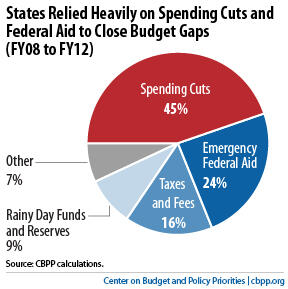BEYOND THE NUMBERS
States made almost $3 in spending cuts for every $1 in new revenues to close the huge budget gaps that resulted from the Great Recession, our new analysis finds. It is the first attempt to quantify how states collectively balanced their budgets in the face of their worst fiscal problems in at least 70 years.
States have cut services by $290 billion and raised taxes and fees by $100 billion since 2008. Spending cuts made up 45 percent of states’ overall budget-balancing actions (see chart), which also included use of emergency federal aid and state budget reserves.
States’ reliance on spending cuts to close budget gaps carries heavy short- and long-term costs for the economy:

- State and local governments have shed 641,000 jobs since August 2008. They have also cancelled contracts with vendors, reduced payments to businesses and nonprofits that provide services, and cut benefit payments to individuals. All of these steps have removed demand from the economy and slowed the recovery.
- By diminishing funding for elementary and high schools, making college less affordable, and reducing residents’ access to health care, the cuts threaten to make the U.S. economy less competitive over the long term.
The mix of budget-balancing measures changed as the fiscal crisis dragged on. In fiscal years 2008-2009, states used reserves to avoid large spending cuts and revenue increases, but the reserves were too small to address a downturn of this magnitude. Emergency federal aid provided through the 2009 Recovery Act played a major role in fiscal years 2009-2011 but then mostly expired. Revenue increases were most prominent in fiscal years 2010-2011.
States cut spending throughout these years, but the largest cuts came in fiscal year 2012, when reserves were exhausted, federal aid had expired, and few states raised taxes. At least 23 states deeply cut pre-kindergarten and/or K-12 spending in 2012, at least 20 states cut health care, and at least half the states cut higher education.
The steep spending cuts of the last few years have caused declines in virtually all services that states provide. Revenues have begun to rebound, but even if they grow much faster than average, they won’t be back on a normal track for a number of years. The bottom line is that states will likely face significant shortfalls for a number of years in funding for education, health care, and other services.
